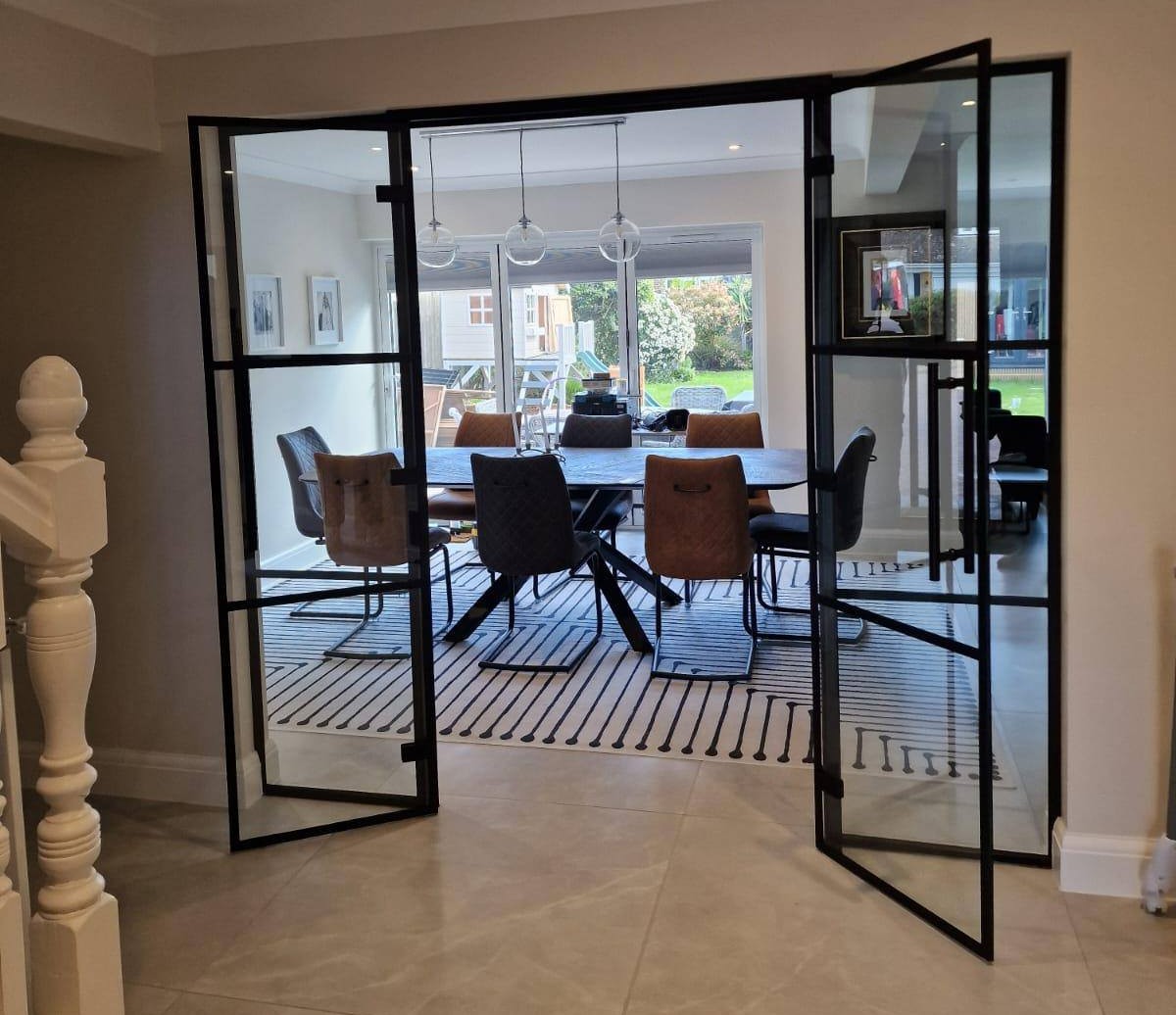
Glass room dividers are a practical and stylish way to create structure within shared spaces. In UK homes and offices, they are increasingly used to define areas in open-plan layouts, introduce privacy in multifunctional rooms, and enhance modern interior schemes.
This guide outlines the different types of dividers available, their benefits, and what to consider before buying so you can choose a solution that fits your space, purpose, and preferences with clarity.
What are Glass Room Dividers?
Glass room dividers are non-load-bearing internal panels used to separate spaces without cutting off visibility or light flow. Designed to provide spatial definition while maintaining visual connection, they are installed across a wide range of domestic settings, from small flats to large family homes.
Common applications include dividing living and dining areas, separating work zones within shared rooms, creating privacy in bathrooms or meeting rooms, or enclosing walk-in wardrobes, breakout spaces, or home studies.
Benefits of Using Glass Room Dividers
1. Natural light transmission: Glass dividers allow light to move through your interior, helping to brighten areas that don’t have direct access to windows.
2. Defined privacy: Frosted or textured glass options provide discretion for workspaces, bedrooms, and bathrooms while still allowing light to pass through.
3. Efficient space use: Glass partitions let you organise space more effectively without the permanence or bulk of traditional walls or joinery.
4. Modern interior appeal: They offer a clean and refined visual, complementing a variety of design styles, from minimal and contemporary to industrial and transitional.
Types of Glass Room Dividers
Frameless glass room dividers
Frameless dividers feature clean, uninterrupted glass panels with minimal visible hardware. They’re often chosen for their sleek, contemporary look and are ideal for modern interiors that prioritise simplicity. While they require precise installation, their minimal structure allows them to integrate seamlessly into a variety of rooms.
Framed glass dividers
These dividers use visible metal or timber frames to hold the glass panels, offering more design variation and structural stability. They are popular in homes and offices that lean toward industrial or classic aesthetics, with options like slim black frames or natural wood finishes to complement surrounding features.
Sliding glass room dividers
Sliding dividers operate on a track system and are a smart solution for rooms where saving space is essential. They work particularly well in small apartments, compact offices, bathrooms, or as movable barriers in shared living or working areas. Their ability to open and close as needed adds both style and adaptability.
Related Read: Sliding Glass Doors
Fixed vs Moveable glass dividers
| Feature | Fixed dividers | Moveable dividers |
|---|---|---|
| Use | Long-term spatial separation | Reconfigurable or temporary zones |
| Setup | Requires permanent installation | Lightweight or modular installation |
| Best for | Dedicated home offices, bathrooms, meeting rooms | Rental properties, studio layouts, coworking spaces |
Factors to Consider Before Purchasing
1. Room size and layout: Accurate measurements are essential. Consider ceiling height, flooring material, and any obstructions like radiators, cornices, or ceiling fixtures in both residential and commercial settings.
2. Glass type and safety features: Always choose tempered or laminated safety glass. These types comply with UK regulations and are designed to reduce risk in case of impact or breakage.
3. Acoustic and privacy needs: For quieter areas like bedrooms, studies, boardrooms, or shared workspaces, acoustic laminated glass is recommended. For discretion, select frosted, reeded, or patterned glass to obscure view while still allowing light to pass through.
4. Installation requirements: Simple, freestanding dividers may suit confident DIYers. However, fixed and sliding systems especially large or ceiling-mounted ones, should always be professionally installed to ensure safety, correct fit, and long-term stability.
Popular Styles & Trends in the UK
1. Minimalist designs
Frameless glass dividers are a go-to choice for minimalist interiors, offering a clean and unobtrusive way to separate spaces without heavy framing or visual distraction; perfect for small flats, modern homes, and streamlined office layouts.
2. Industrial-style dividers
Black-framed glass partitions, often designed in a Crittall-style grid layout, are popular in urban homes, converted lofts, creative studios, and contemporary office fit-outs. They add structure and visual interest to large open interiors.
3. Sustainability trends
Tempered or laminated glass dividers made with recycled content and are increasingly chosen by eco-conscious homeowners and business owners aiming to reduce their environmental footprint during renovations.
Maintenance & Care
1. Cleaning: Use non-abrasive, ammonia-free glass cleaner and a soft cloth to prevent streaks or surface damage.
2. Hardware care: For sliding systems, clean tracks and lubricate regularly. For hinged systems, tighten fixings and check seals twice a year.
3. General maintenance: Inspect joints and glass edges periodically. Address chips or scratches early to avoid spreading or cracking.
Cost Considerations
| Divider type | Average cost (UK) |
|---|---|
| Frameless glass divider | £350 – £800 per panel |
| Framed glass divider | £250 – £600 per panel |
| Sliding glass divider | £400 – £900 (with track system) |
| Custom designs & finishes | +£150–£300 depending on style |
What affects cost: Glass thickness, frame type, installation complexity, and any privacy or acoustic upgrades, custom finishes, etching, and coloured frames.
FAQs
Yes. For workspaces that require quiet zones or privacy during meetings, acoustic laminated glass or double-glazed dividers help reduce sound transmission and support focused work.
.
Absolutely. Glass dividers are often installed during home upgrades as a less invasive alternative to permanent walls. They can be fitted into existing layouts without extensive structural changes.
Sliding or framed frosted glass dividers are ideal for shared home offices. They separate the space while keeping it bright, and provide the discretion needed for virtual calls, focus work, or staggered schedules.
Yes. In both homes and offices, dividers can be customised with tinted glass, etched patterns, coloured frames, or printed designs to suit your interior style or brand identity.
Definitely. Sliding, folding, or corner-mounted systems work especially well in tighter layouts. They help manage space more effectively while still offering practical division.
It depends on your priorities. Frameless dividers offer a clean, uninterrupted view, making them ideal for minimal interiors. Framed options provide stronger architectural lines and more durability, especially useful in commercial or high-traffic areas.














